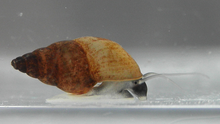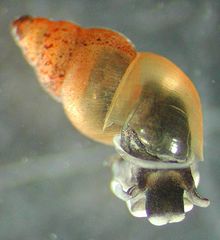Potamopyrgus antipodarum
| New Zealand mudsnail | |
|---|---|
 |
|
| right side view of Potamopyrgus antipodarum | |
 |
|
| Scientific classification | |
| Kingdom: | Animalia |
| Phylum: | Mollusca |
| Class: | Gastropoda |
| (unranked): |
clade Caenogastropoda clade Hypsogastropoda |
| Superfamily: | Truncatelloidea |
| Family: | Tateidae |
| Genus: | Potamopyrgus |
| Species: | P. antipodarum |
| Binomial name | |
|
Potamopyrgus antipodarum J. E. Gray, 1843 |
|
| Synonyms | |
|
|
clade Hypsogastropoda
clade Littorinimorpha
The New Zealand mudsnail (Potamopyrgus antipodarum) sometimes previously known as Potamopyrgus jenkinsi, is a species of very small or minute freshwater snail with a gill and an operculum, an aquatic gastropod mollusk in the family Hydrobiidae.
It is an invasive species in many countries, where populations of the snail can reach phenomenal densities.
The shell of Potamopyrgus antipodarum is elongated and has dextral coiling. The shell has 7 or 8 whorls. Between whorls are deep grooves.
It is an operculate snail, with a 'lid' that can seal the opening of its shell. The operculum is thin and corneus with an off-centre nucleus from which paucispiral markings (with few coils) radiate. The aperture is oval and its height is less than the height of the spire.
Some morphs, including many from the Great Lakes, exhibit a keel in the middle of each whorl; others, excluding those from the Great Lakes, exhibit periostracal ornamentation such as spines for anti–predator defense.
Shell colors vary from gray and dark brown to light brown.
The average height of the shell is approximately 5 mm ( in); maximum size is approximately 12 mm ( in). The snail is usually 4–6 mm in length in the Great Lakes, but grows to 12 mm in its native range.
...
Wikipedia



